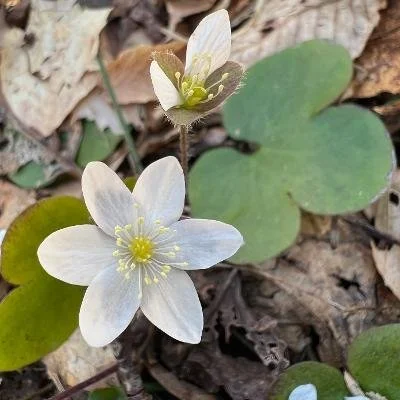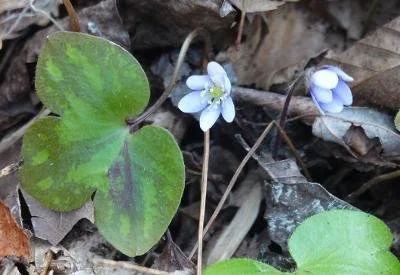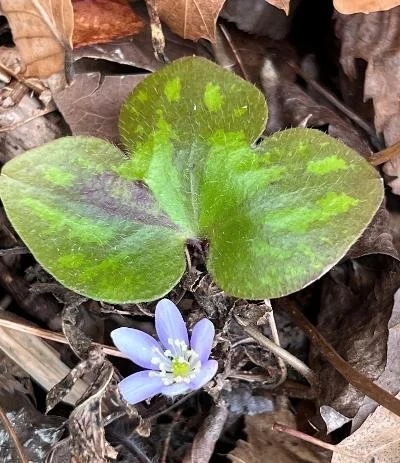Plant of the Month February 2023: Round-lobed Hepatica or Liverleaf
Round-lobed Hepatica with white flowers (Photo by Anne Parker)
Round-lobed Hepatica, Hepatica americana
February 2023 Plant of the Month
By Betsy Washington
One of the earliest signs of spring is the bloom of the Round-lobed Hepatica or Liverleaf, Hepatica americana. The lovely small flowers of this woodland wildflower look fragile but this hardy perennial blooms in the face of winter often in February. An array of adaptations helps it survive this period of winter-spring. The leathery leaves are often partially hidden under a blanket of insulating forest duff and the flowers emerge through this duff while the canopy is bare. The evergreen leaves are able to photosynthesize during the winter as the sun reaches the forest floor, giving Hepaticas a head start over other early wildflowers. Although various early pollinators (solitary bees and flies) seek pollen for their larvae from Hepaticas, the flowers themselves lack nectar, and instead sometimes rely on self-pollination; an amazing adaptation that saves energy and guarantees pollination in the fickle early spring weather when pollinators are often scarce. Further, the flowers close during the night and on rainy days thereby preserving their pollen and open only when pollinators are flying. Once the flowers are pollinated, they develop into round seedheads with a tiny nutritious bundle of fats and protein (an elaisome) attached to each seed. This nutritious bundle is irresistible to ants which eagerly carry the bundle along with the seed back to their nests. There they eagerly devour the elaisome and then discard the seeds in their refuse piles, essentially planting them in in the rich soil safely hidden from herbivores. What a marvelous web of adaptations and relationships in one small wildflower!
Round-lobed Hepaticas are found throughout eastern North America in both dry to moist upland forests, on rich wooded slopes, ravines, in well drained floodplains and on mossy banks. In Virginia, they are found in nearly every county except on eastern shore. Although they are common in the Mountain and Piedmont provinces, they are infrequent in the Coastal Plain, making them that much more exciting to find. You can find several along the Cabin Swamp trail at Hickory Hollow or on rich ravine slopes above the Dragon Run Swamp in the middle Peninsula.
Round-lobed Hepatica flaunting its blue flowers on February 10 (by Betsy Washington)
This diminutive member of the Buttercup family is easy to miss since the evergreen leaves are often hidden beneath an insulating blanket of leaf litter. Hepaticas are stemless and grow only 4 – 8” tall with distinctive rounded basal leaves up to 3” wide. Each leathery leaf has three rounded lobes, supposedly resembling a liver in shape. After flowering, new leaves covered with silky white hairs emerge. The delicate white, blue, lavender or even pink flowers are stunning and will stop you in your tracks and warm your floral heart even the coldest spring days. The delicate flowers are only 1” wide and held on slender silky stalks above the leaves. Each flower has from 5 – 12 petal-like sepals that surround a showy burst of pale whitish stamens and anthers and are particularly beautiful framed against the leathery basal leaves, often mottled with burgundy from winter cold. Round-lobed Hepaticas may bloom anytime from February to early April so begin looking for them now. A closely related species, Sharp-lobed Hepatica, occurs only in the mountains in western Virginia and can be further distinguished by its acute or pointed lobed leaves. It also blooms in early spring.
The Latin name Hepatica and common name “Liverleaf” both refer to Hepatica’s purported resemblance in shape and winter color to liver. Writings from the Middle Ages, referred to as the “Doctrine of Signatures” held that the shape or look of a plant indicated its healing properties, thus early settlers made an herbal tea with the leaves of hepaticas to treat various liver ailments. Apparently, many followed this false science but some fell ill and even died.
Handsome mottled leaves and bloom of Round-lobed Hepatica (by Kevin Howe)
Today it is far better and safer to enjoy this precocious wildflower while hiking in rich woodlands or to grow it in our own woodland garden. Hepaticas prefer rich well drained soils beneath deciduous trees where they can soak up winter light. The well branched roots dislike transplanting but once established Hepaticas tolerate both dry and moist soils but are happiest with consistent moisture. And when happy they may seed themselves into large drifts creating an early spring spectacle. Like other members of the Buttercup family, they are unpalatable to deer – an added bonus. Plant them in a spot at the front of the border or along a path away from crowding neighbors and competition. This is the perfect way to admire their precocious blooms; they will surely lift your spirits and assure you that spring is on its way. Take a walk to Cabin Swamp Hickory Hollow Natural Area Preserve in the coming weeks and look just off the trails for this lovely late winter bloomer.



